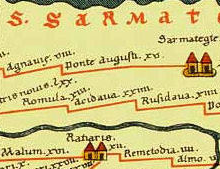
Argedava was an important Dacian town mentioned in the Decree of Dionysopolis (48 BC), and potentially located at Popești, a district in the town of Mihăilești, Giurgiu County, Muntenia, Romania.
Romula or Malva was an ancient city in Roman Dacia, later the village of Reşca, Dobrosloveni Commune, Olt County, Romania. It was the capital of Dacia Malvensis, one of the three subdivisions of the province of Dacia.

The Burs were a Dacian tribe living in Dacia in the 1st and 2nd centuries A.D., with their capital city at Buridava.
Quemedava was an ancient Dacian city in Dardania mentioned by Procopius.

Argidava was a Dacian fortress town close to the Danube, inhabited and governed by the Albocense. Located in today's Vărădia, Caraș-Severin County, Romania.

Acidava (Acidaua) was a Dacian and later Roman fortress on the Olt river near the lower Danube. The settlements remains are located in today's Enoşeşti, Olt County, Oltenia, Romania.

Dava was a Geto-Dacian name for a city, town or fortress. Generally, the name indicated a tribal center or an important settlement, usually fortified. Some of the Dacian settlements and the fortresses employed the Murus Dacicus traditional construction technique.
Bregedava was a Dacian town.
Buricodava was a Dacian town.
Buteridava was a Dacian town.
Carsidava was a Dacian town. Recent research placed Carsidava near Soroca town in Moldova.
Itadava was a Dacian town, in the territory of the fortress with unknown name near Burgaraca.
Marcodava was a Dacian town, north-west of Apulon.
Pelendava was a Dacian town.
Scaidava was a Dacian town between Iatrus and Trimammium (Ablanovo) near the village of Batin, Bulgaria.

Sacidava was an ancient Getic settlement on the Danube, between Durostorum and Axiopolis, located near the modern village of Izvoarele, in Romania.
Keiladeva was a Dacian town mentioned in toponomastic inscriptions.

Arutela was an ancient Roman fort in the Roman province of Dacia today near the town Călimănești. It lies on the left bank of the Olt River. It was part of the Roman frontier system of the Limes Alutanus,
Arcobara was a Dacian town mentioned by Ptolemy.














